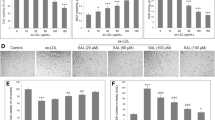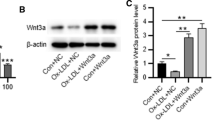Abstract
Endothelial cells are a crucial component of the vessel-tissue wall and exert an important role in atherosclerosis (AS). To explore the role of Orientin in AS, human vascular endothelial cells (HUVECs) were induced by oxidized low-density lipoprotein (ox-LDL) to simulate the vascular endothelial injury during AS. Cell viability was detected by CCK-8 assay. Oxidative stress and inflammation related markers were measured using kits, RT-qPCR or western blot. Besides, cell apoptosis was assessed with TUNEL staining and cell autophagy was evaluated by LC3 immunofluorescent staining. Additionally, western blot was utilized to evaluate the expression of Sestrin 1 (SESN1) and proteins in AMPK/mTOR signaling. Afterwards, SESN1 was silenced to determine the expression of autophagy-related proteins. The further application of autophagy inhibitor 3-methyladenine (3-MA) was used to clarify the regulatory mechanism of Orientin on autophagy. Results showed that the decreased viability of HUVECs caused by ox-LDL induction was elevated by Orientin. Oxidative stress and inflammation were also attenuated after Orientin addition in HUVECs under ox-LDL condition. Moreover, Orientin suppressed apoptosis and induced autophagy of HUVECs stimulated by ox-LDL, accompanied by enhanced level of phospho (p)-AMPK and declined level of p-mTOR. Interestingly, SESN1 level was elevated by Orientin, and SESN1 depletion alleviated autophagy and reduced p-AMPK expression but enhanced p-mTOR expression. The further experiments indicated that SESN1 silencing or 3-MA addition reversed the inhibitory effects of Orientin on the oxidative stress, inflammation and apoptosis of HUVECs. Collectively, Orientin could induce autophagy by activating SESN1 expression, thereby regulating AMPK/mTOR signaling in ox-LDL-induced HUVECs.







Similar content being viewed by others
Data availability
The datasets generated for this study are available on request to the corresponding author.
References
Afsar B, Turkmen K, Covic A, Kanbay M (2014) An update on coronary artery disease and chronic kidney disease. Int J Nephrol 2014:767424
Budanov AV, Karin M (2008) p53 target genes sestrin1 and sestrin2 connect genotoxic stress and mTOR signaling. Cell 134:451–460
Cao Q, Du H, Fu X, Duan N, Liu C, Li X (2020) Artemisinin attenuated atherosclerosis in high-fat diet-fed ApoE−/− mice by promoting macrophage autophagy through the AMPK/mTOR/ULK1 pathway. J Cardiovasc Pharmacol 75:321–332
Che J, Liang B, Zhang Y, Wang Y, Tang J, Shi G (2017) Kaempferol alleviates ox-LDL-induced apoptosis by up-regulation of autophagy via inhibiting PI3K/Akt/mTOR pathway in human endothelial cells. Cardiovasc Pathol 31:57–62
Choi AM, Ryter SW, Levine B (2013) Autophagy in human health and disease. N Engl J Med 368:651–662
Cordani M, Butera G, Dando I et al (2018) Mutant p53 blocks SESN1/AMPK/PGC-1alpha/UCP2 axis increasing mitochondrial O2− production in cancer cells. Br J Cancer 119:994–1008
Ding Z, Liu S, Wang X, Khaidakov M, Dai Y, Mehta JL (2013) Oxidant stress in mitochondrial DNA damage, autophagy and inflammation in atherosclerosis. Sci Rep 3:1077
Fan X, Wang J, Hou J et al (2015) Berberine alleviates ox-LDL induced inflammatory factors by up-regulation of autophagy via AMPK/mTOR signaling pathway. J Transl Med 13:92
Frostegård J (2013) Immunity, atherosclerosis and cardiovascular disease. BMC Med 11:117
Fu XC, Wang MW, Li SP, Wang HL (2006) Anti-apoptotic effect and the mechanism of orientin on ischaemic/reperfused myocardium. J Asian Nat Prod Res 8:265–272
Fukai T, Ushio-Fukai M (2011) Superoxide dismutases: role in redox signaling, vascular function, and diseases. Antioxid Redox Signal 15:1583–1606
Gao S, Liu J (2017) Association between circulating oxidized low-density lipoprotein and atherosclerotic cardiovascular disease. Chronic Dis Transl Med 3:89–94
Gawel S, Wardas M, Niedworok E, Wardas P (2004) Malondialdehyde (MDA) as a lipid peroxidation marker. Wiad Lek 57:453–455
Hamasaki M, Shibutani ST, Yoshimori T (2013) Up-to-date membrane biogenesis in the autophagosome formation. Curr Opin Cell Biol 25:455–460
He D, Xu L, Wu Y et al (2020) Rac3, but not Rac1, promotes ox-LDL induced endothelial dysfunction by downregulating autophagy. J Cell Physiol 235:1531–1542
Jensen HA, Mehta JL (2016) Endothelial cell dysfunction as a novel therapeutic target in atherosclerosis. Expert Rev Cardiovasc Ther 14:1021–1033
Kang H, Yu H, Fan J, Cao G (2021) Rotigotine protects against oxidized low-density lipoprotein(ox-LDL)-induced damages in human umbilical vein endothelial cells(HUVECs). Bioengineered 12:10568–10579
Keping Y, Yunfeng S, Pengzhuo X, Liang L, Chenhong X, Jinghua M (2020) Sestrin1 inhibits oxidized low-density lipoprotein-induced activation of NLRP3 inflammasome in macrophages in a murine atherosclerosis model. Eur J Immunol 50:1154–1166
Kim M, Kowalsky AH, Lee JH (2021) Sestrins in physiological stress responses. Annu Rev Physiol 83:381–403
Kregel KC, Zhang HJ (2007) An integrated view of oxidative stress in aging: basic mechanisms, functional effects, and pathological considerations. Am J Physiol Regul Integr Comp Physiol 292:R18-36
Ku SK, Kwak S, Bae JS (2014) Orientin inhibits high glucose-induced vascular inflammation in vitro and in vivo. Inflammation 37:2164–2173
Lawal AO, Davids LM, Marnewick JL (2016) Diesel exhaust particles and endothelial cells dysfunction: An update. Toxicol In Vitro 32:92–104
Lee JH, Cho US, Karin M (2016) Sestrin regulation of TORC1: Is Sestrin a leucine sensor? Sci Signal 9:re5
Li F, Zong J, Zhang H et al (2017) Orientin reduces myocardial infarction size via eNOS/NO signaling and thus mitigates adverse cardiac remodeling. Front Pharmacol 8:926
Li W, Li Y, Zhao Y, Ren L (2020a) The protective effects of aloperine against ox-LDL-induced endothelial dysfunction and inflammation in HUVECs. Artif Cells Nanomed Biotechnol 48:107–115
Li C, Cai C, Zheng X, Sun J, Ye L (2020b) Orientin suppresses oxidized low-density lipoproteins induced inflammation and oxidative stress of macrophages in atherosclerosis. Biosci Biotechnol Biochem 84:774–779
Li X, Zhou J, Dou Y et al (2020c) The protective effects of angelica organic acid against ox-LDL-induced autophagy dysfunction of HUVECs. BMC Complement Med Ther 20:164
Li L, Chen Y, Shi C (2022d) Nintedanib ameliorates oxidized low-density lipoprotein -induced inflammation and cellular senescence in vascular endothelial cells. Bioengineered 13:6196–6207
Libby P, Buring JE, Badimon L et al (2019) Atherosclerosis. Nat Rev Dis Primers 5:56
Lin HH (2015) In vitro and in vivo atheroprotective effects of gossypetin against endothelial cell injury by induction of autophagy. Chem Res Toxicol 28:202–215
Liu L, Wu Y, Huang X (2016) Orientin protects myocardial cells against hypoxia-reoxygenation injury through induction of autophagy. Eur J Pharmacol 776:90–98
Livak KJ, Schmittgen TD (2001) Analysis of relative gene expression data using real-time quantitative PCR and the 2(-Delta Delta C(T)) Method. Methods 25:402–408
Martinet W, De Meyer GR (2009) Autophagy in atherosclerosis: a cell survival and death phenomenon with therapeutic potential. Circ Res 104:304–317
Mizushima N, Komatsu M (2011) Autophagy: renovation of cells and tissues. Cell 147:728–741
Mizushima N, Levine B, Cuervo AM, Klionsky DJ (2008) Autophagy fights disease through cellular self-digestion. Nature 451:1069–1075
Monteiro JP, Bennett M, Rodor J, Caudrillier A, Ulitsky I, Baker AH (2019) Endothelial function and dysfunction in the cardiovascular system: the long non-coding road. Cardiovasc Res 115:1692–1704
Pennathur S, Heinecke JW (2007) Oxidative stress and endothelial dysfunction in vascular disease. Curr Diab Rep 7:257–264
Su Q, Sun Y, Ye Z, Yang H, Kong B, Li L (2018) Pinocembrin protects endothelial cells from oxidized LDL-induced injury. Cytokine 111:475–480
Xiao Q, Piao R, Wang H, Li C, Song L (2018) Orientin-mediated Nrf2/HO-1 signal alleviates H2O2-induced oxidative damage via induction of JNK and PI3K/AKT activation. Int J Biol Macromol 118:747–755
Zhang J, Wang Z, Zhang J et al (2014) Rapamycin attenuates endothelial apoptosis induced by low shear stress via mTOR and sestrin1 related redox regulation. Mediators Inflamm 2014:769608
Zhang S, Guo C, Chen Z, Zhang P, Li J, Li Y (2017) Vitexin alleviates ox-LDL-mediated endothelial injury by inducing autophagy via AMPK signaling activation. Mol Immunol 85:214–221
Zhang X, Sun D, Song JW et al (2018) Endothelial cell dysfunction and glycocalyx-A vicious circle. Matrix Biol 71–72:421–431
Zhang X, Han X, Zhang P et al (2019) Morin attenuates oxidized low-density lipoprotein-mediated injury by inducing autophagy via activating AMPK signalling in HUVECs. Clin Exp Pharmacol Physiol 46:1053–1060
Zheng XT, Wu ZH, Wei Y et al (2017) Induction of autophagy by salidroside through the AMPK-mTOR pathway protects vascular endothelial cells from oxidative stress-induced apoptosis. Mol Cell Biochem 425:125–138
Zhu Z, Li J, Zhang X (2019) Astragaloside IV protects against oxidized low-density lipoprotein (ox-LDL)-induced endothelial cell injury by reducing oxidative stress and inflammation. Med Sci Monit 25:2132–2140
Funding
Not applicable.
Author information
Authors and Affiliations
Contributions
FG and YZ designed the study. FG, YZ, BZ, CX, ZS, YG and XD performed the experiments and analyzed the data. BZ and CX drafted the manuscript and interpreted the data. FG revised the manuscript for important intellectual content. All authors have read and approved the final version of the manuscript.
Corresponding author
Ethics declarations
Conflict of interest
The authors declare no competing interests.
Research involving human and animal rights
Only cell experiments in this study. And this article does not contain any studies with human participants or animals performed by any of the authors.
Additional information
Publisher's Note
Springer Nature remains neutral with regard to jurisdictional claims in published maps and institutional affiliations.
Rights and permissions
Springer Nature or its licensor (e.g. a society or other partner) holds exclusive rights to this article under a publishing agreement with the author(s) or other rightsholder(s); author self-archiving of the accepted manuscript version of this article is solely governed by the terms of such publishing agreement and applicable law.
About this article
Cite this article
Gao, F., Zhao, Y., Zhang, B. et al. Orientin alleviates ox-LDL-induced oxidative stress, inflammation and apoptosis in human vascular endothelial cells by regulating Sestrin 1 (SESN1)-mediated autophagy. J Mol Histol 55, 109–120 (2024). https://doi.org/10.1007/s10735-023-10176-z
Received:
Accepted:
Published:
Issue Date:
DOI: https://doi.org/10.1007/s10735-023-10176-z




